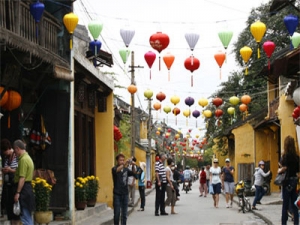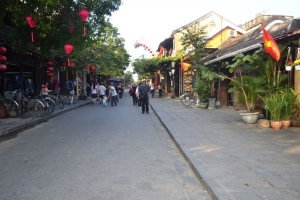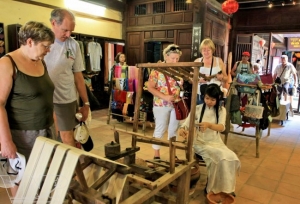Quang Nam takes measures for heritage value preservation
The province continues to collaborate with relevant agencies, international organisations and scientists to study the Cham architecture in different aspects with a view to restoring the My Son Sanctuary in a scientific and concerted manner, Nguyen Chin, Vice Chairman of the Quang Nam People’s Committee said.
Meanwhile in Hoi An ancient town, the province will take appropriate policies for collective and individual owned relics, including the provision of timber for the restoration, Chin told the December 16 conference on preserving and promoting the two UNESCO cultural heritage sites after 15 years getting the world status.
Apart from building special policies on investment and procedures for its preservation works, the province will continue carrying out its international programmes to take advantage of investment and technologies in the effort, he added
Over the past 15 years, the two heritage sites have been invested 502 billion VND (24 million USD) for preservation works from different sources.
Earlier, the Prime Minister approved plans on preserving and promoting values of the My Son Sanctuary and Hoi An ancient town for the 2008-2020 and 2012-2025 periods, respectively.-VNA
Quang Nam - The land of “Water convergence –People convergence – Culture convergence”
Let’s visit this destination once to discover and be proud of the land of Culture, Competition - examinations and Extraordinary persons.
Quang Nam new land’s residents, the first Vietnamese came into contact with Western culture through Catholic missionaries, businesspersons, and then with the Chinese, the Japanese by Hoi An trading port. The exchanges with different cultures have remained the various dark and light stamps in social activities which have expressed in the popular cultural structure.
When coming to Quang Nam, tourists will enjoy interesting experiences on the way of living, friendly attitudes and simple life of local residents. Visitors will also live in the ancient and mild space of Hoi An ancient town that was selected “the most popular city in the world in 2012” by Wanderlust Travel magazine.

Hoi An ancient town
Hoi An city has attracted tourists by its ancient figures of side by side small and moss houses. Entering the ancient quarter, tourists would be at fault in an isolated world which has been separated from the destruction of time. There is neither any noise of engines nor shops being shined by bright colourful lights. All those things are just the past. Its time and space have been engraved in the ancient wooden house, in the Japanese bridge, two-storey wooden houses standing beside the Hoai river banks which are silently existing for human’s thinking of a time of the past.

My Son Sanctuary
Coming to My Son Sanctuary Site, which was recognized as a World Cultural Heritage by UNESCO in 1999, the tourists can contemplate the mystical and fanciful beauty of its monuments. Many towers are decorated with genie statues and beautiful patterns. This World Cultural Heritage’s construction was under the India’s architectural influence. A sanctuary, the first place of worship at My Son which was built in the 4th century, is still remained overhere. King Bhadrésvara founded the first Champa dynasty in Amaravati region in the late of the 4th century. After passing away, he has been worshipped at My Son The main tower is the holy place to worship the Linga and Shiva statues. The Shiva God was “the King‘s protection”.
My Son is known as a beautiful cultural treasure of the ancient Cham people and a lively architectural museum of the aesthetics of humanity. Despite ravages of war and time, My Son Sanctuary stands as a witness to the history of the ancient Champa, and is an important part of the world’s cultural heritages.

Phu Ninh lake
Located about 7km from Tam Ky city center is the Phu Ninh lake. Looking down from a hill, the lake looks like a young girl lying across a green land zone of Quang Nam. Phu Ninh makes tourists amorous by its scenery like a watercolor painting. This lake is valued as a paradise for anyone who wants to the urban noise peace. There are about 30 islets in the lake. Tourists can visit them and the whole lake by canoes.

Bang An temple
Quang Nam province has restored hundreds of Vietnamese old architectural constructions such as houses, temples, pagodas, communal houses which were built from 300-500 years ago. The values of those relics are not only in their cultural and artistic characters, but also in their important historical meanings which have expressed the long development of a cultural region of the Dang Trong. The ancient Champa Tra Kieu capital, Khuong My, Chien Dan, Bang An temples, Dong Duong Buddhist Institute are the places which have engraved the bright stamps of the Sa Huynh, Champa, Dai Viet civilizations.

A bamboo weaving village in Quang Nam
The cultural values of Quang Nam province are not only showed in its ancient architectural constructions but also in unique cultural figures of customs, habits and traditional festivals. All traditional festivals of Quang Nam bring spiritual and religious facts. They are held every year to wish good weather, calm sea, peace for country, to praise the ancestors, look back their family source, national tradition and give expression to the aspiration for the True, the Good and the Beautiful. Quang Nam is also a place where the traditional craft villages have been established and developed since hundreds or thousands of years. With many changes of the country, those craft villages have still existed and developed as an undetachable part of their history.

Quang noodle
In addition, Quang Nam’s famous dishes such as My Quang (Quang Noodle), Cao lau, Be thui (barbacued veal), Banh trang thit heo (Flat rice pancake with pork and vegetable), Bánh vac (White rose), Banh to (glutinous rice cake) have created a very private figure of Quang Nam cuisine. Quang Nam foods are simple in cooking but moreish in quality. Quang Noodle is a familiar dish of the Vietnamese in many places including foreign tourists.
When talking about Quang Nam cultural sub-region, we have to mention its folk art treasure of Ve Quang and Ho (Vietnamese folk melody) such as Ho di cay, Ho xay lua, Ho Tat Nuoc, Ho Gia Gao, Ho Gia Voi, Ho Dạp xe Nuoc, Ho Khoan, Ho Ba Ly, Hat Ba Trao, Hat Nhan Ngai, Bai Choi which are performed with Quang Nam’s dialect and charming voice…
Let’s visit to Quang Nam once to discover the beauty of a Vietnam Central province - the land of “Water convergence –People convergence – Culture convergence”.
Visit Quang Nam silk village
Tourists who have a chance to visit the central coast province of Quang Nam should check out Silk Village at 28 Nguyen Tat Thanh Street in Hoi An.
The venue was established by Le Thai Vu, the owner of Quang Nam Silk JSC, in July 2012 to restore traditional cultural traits of Quang Nam in general and Hoi An in particular. Hoi An was once a trade port to deliver silk to the world. Local people used to call it the starting point of the Silk Road on the sea by Vietnamese people.
Tourists to the place can learn about the process of making traditional silk of Quang Nam and Champa brocade. There’s a tour guide to help guests learn about 10 kinds of mulberry leaves, looms and types of worms. Furthermore, tourists have a chance to discover nha vuon, a typical and unique kind of house made from wood and surrounded by a garden mostly found in the central province of Quang Nam. Artisans will also be there to sing traditional folk songs to entertain travelers. The village is also a venue to host vocational guidances on producing silk.
There’s a collection of 100 ancient costumes of 54 ethnic minority people in Viet Nam.
Tourists can buy silk and have their outfits tailored at the village. Then, they can savor numerous kinds of traditional and rustic food of the locality, including cao lau (noodles served with pork and greens), mi Quang (Quang Nam-style noodles), and com nieu (rice cooked in a clay pot).
Silk Village is about 30km from downtown Da Nang. Travelers can choose a 30-minute bus ride at the price of VND20,000 or US$1 per person to get to the site.








































































































